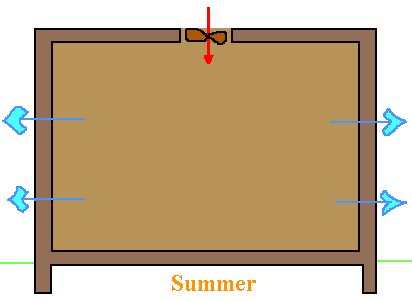INDOOR AIR QUALITY
- GOAL:
- To become aware of designs and construction that will save energy and create a healthier environment.
- OBJECTIVE:
- The student will demonstrate knowledge and understanding of the problems of indoor air quality.
- GLOSSARY:
- Outgas
- - Fumes that are given off by most materials especially when they are heated.
- Heat Exchanger
- A device for transferring heat from one fluid to another without allowing them to mix.
- Electrostatic Filters - Static electricity is produced in the self-charging mechanical filter, by air rushing through it; thus larger particles cling to the filters.
- LESSON / INFORMATION:
- For thousands of generations, people have lived in close harmony with their natural environment. Their food, water, clothing and shelter came from natural sources. Housing was constructed with local materials. Now most of our food is grown with chemical fertilizers, treated with herbicides and pesticides, processed with additives and preservatives, wrapped in plastic or foam material, and sent thousands of miles away to be consumed. Water is chemically treated and distributed through pipes which impart traces of metals or plastics. Our clothing is made with artificial fibers treated with synthetic dyes, finishes, moth-proofing, and fire retardants. Buildings are no longer crafted but are engineered airtight, insulated boxes made from manufactured components which outgas (emit fumes) into the stagnant inside air.
- Indoor air pollution can be a major problem to your health. Airborne pollutants are divided into two classes: Particulate matter (such as plant, animal, mineral and manmade dust including pollen, mold spores, dust mites, asbestos, soot, smoke, etc.) and gas (combustion products, natural gas or propane, radon, petrochemical fumes, plus vapor outgassed from plastics, paints, furnishings, finishes, building materials, and household products like oven cleaners). Special design precautions should be taken to assure that at least the minimum fresh air standard, which is a one-third air change per hour (one complete air change in three hours), are met. Air change is measured in how much indoor air has been replaced by fresh outside air in one hour. Opening an exterior door usually takes care of this exchange. The standard technique for efficiently bringing in fresh air is through a heat exchanger to capture or reclaim the spent energy / comfortable temperatures. Another method being investigated in colder climates is a breathable envelope. The exterior wall allows colder outside fresh air to move through the wall under a very slight negative interior pressure by way of an exhaust fan. This reverses the normal flow of heat from the interior on to the exterior, thereby recapturing the lost heat and claims to save 7.5% on energy requirements when compared to a heat exchanger. This system keeps the exterior wall temperature cooler and drier.

- For Louisiana climates it seems that it would work that way only with a positive interior pressure pushing the cooler air to the exterior. In fact, it would be easy to reverse the pressure with seasons. Regardless, if the wall is designed correctly, it could be a good filter system.

- Electrostatic filters are also used to fight electromagnetic pollution which comes in several forms. Natural air is ionized in equal amounts of positive and negative ions. Ions increase and decrease with changes in temperature, humidity, winds, the moon, cloudy or clear skies, and they change polarity during thunderstorms, when near waterfalls, and seashores or in the mountains.
- The electromagnetic pulse, that everything has, does not cycle at the same rate. The body's rhythm and that of the Earth's is pretty much one and the same. When deprived of this natural rhythm, the body becomes weaker. This natural rhythm may be disturbed by steel buildings or electrical currents found in electric blankets or computer terminals. Some stone material might also create powerful magnetic fields.
- The basic design approach is to eliminate, separate, and ventilate. We just touched on the latter two, but the first principal is to prevent the problem. A renewed design emphasis in natural local building materials, used in such a way to prevent these problems from being created, is the solution.
- ACTIVITY:
- Please indicate whether the following statements are true or false.
- ___1. In the past, people lived in harmony with their natural environment.
- ___2. Today much of our food, clothes, and building materials are chemically treated.
- ___3. Indoor air pollution cannot hurt your health.
- ___4. Airborne pollutants are either particle matter or gases.
- ___5. Fresh air standards require one air change per hour.
- ___6. Electrostatic filters in connection with the HVAC system will reduce indoor air pollution.
- ___7. The first step is to eliminate pollutants from the interior.
- ___8. If you smoke you are not only hurting yourself, but you are polluting the air for others.
- ___9. A good solution is to leave some of the windows open all year round.
- ___10. The basic design approach is to eliminate, separate, and ventilate pollutants.
- TEACHER'S NOTES:
- Answers to True / False.
- 1. True
- 2., True
- 3. False
- 4. True
- 5. False
- 6. True
- 7. False
- 8. True
- 9. False
- 10. True
- RECOMMENDED READING:
- Building Control Systems. V. Bradshaw. New York: John Wiley & Sons, 1985.
- Natural Louisiana Architecture. Cazayoux, Hebert and Winn. Baton Rouge, LA: Louisiana Department of Natural Resources, 1991.
- REFERENCES:
- "The Comfort Zone" .....E. J. Cazayoux, USL Monthly Press Release.
Comments or questions to: TechAsmt@LA.GOV
Return to Drafting Menu



